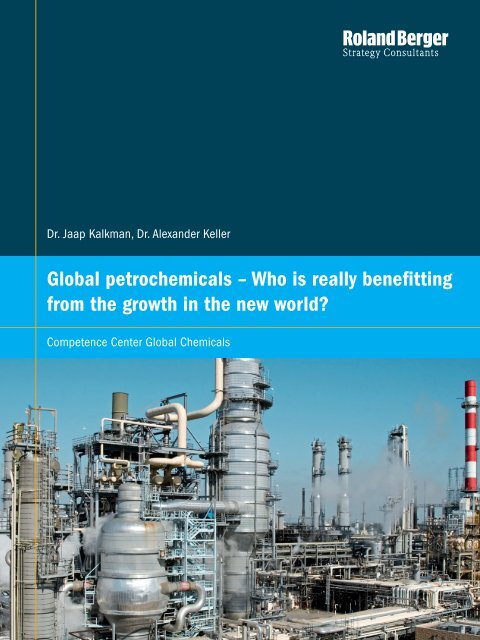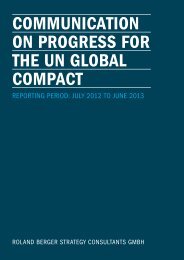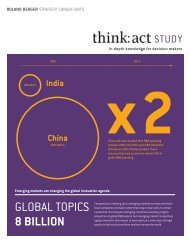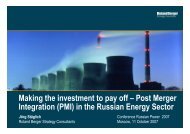Global petrochemicals - Roland Berger Strategy Consultants
Global petrochemicals - Roland Berger Strategy Consultants
Global petrochemicals - Roland Berger Strategy Consultants
- No tags were found...
You also want an ePaper? Increase the reach of your titles
YUMPU automatically turns print PDFs into web optimized ePapers that Google loves.
Competence Center <strong>Global</strong> Chemicals 1Dr. Jaap Kalkman, Dr. Alexander Keller<strong>Global</strong> <strong>petrochemicals</strong> – Who is really benefittingfrom the growth in the new world?Competence Center <strong>Global</strong> Chemicals
2<strong>Global</strong> <strong>petrochemicals</strong> – Who is really benefitting from the growth in the new world?Europe and the US historical hubs for the <strong>petrochemicals</strong>industryBuilding on both abundant oil and natural gas resources and strong government support,Europe and the US have developed large petrochemical clusters. In the US, Houston'sGalveston Bay hydrocarbon cluster was producing 30% of the country's petroleum and50% of its ethylene and propylene already in the 1940s. In Europe, the first petrochemicalcluster was established in 1955 in Rotterdam to provide companies operating along thepetrochemical value chain easy access to feedstock. A second cluster soon followed:Established in 1963, the Antwerp cluster has since become Europe's largest centerfor ethylene production.These early establishments of petrochemical clusters coincided with significant demand inthe West, location not being an issue because of the collocation of market and feedstockaccess. Then the increase in demand for oil, lubricants and synthetic rubbers during WorldWar II along with the commercialization and internationalization of new technologies duringthe reconstruction of Europe afterwards helped grow the industry further. In 1980, Europeand North America accounted for roughly 62% of the global <strong>petrochemicals</strong> production.Governments play a key role in developing the <strong>petrochemicals</strong> industry by incentivizingthe establishment of clusters and R&D activities, building the necessary infrastructure andsetting up the supporting educational system. This has helped establish Europe and the USas knowledge and technology centers for the entire industry. However, new entrants beganchallenging their dominance during the 1980s and 1990s on the grounds of cheapfeedstock as well as targeted governmental investments and protectionist measures.
4<strong>Global</strong> <strong>petrochemicals</strong> – Who is really benefitting from the growth in the new world?Demand is moving EastMarket growth in polyolefins 1) is increasingly being driven by Asia Pacific and morespecifically by China. The consumption in China is expected to grow at high annual ratesthroughout the decade, contributing to a healthy expected consumption growth rate inall of Asia of 5.5% per annum. A similar pattern is expected for Latin America, whereconsumption of <strong>petrochemicals</strong> is expected to increase substantially going forward,albeit from a lower base.The key underlying driver for this strong market growth in Asia is the economic developmentin China and to a slightly lesser extent in India. China currently has a per capita consumptionof polyethylene and polypropylene of 10 kg per year, which is considerably less than theEuropean per capita consumption of 45 kg per year. Estimates suggest approximately500 million additional consumers will spend increasing proportions of their income onnon-food items over the next 15 years. Many of these will be products derived from orbased on <strong>petrochemicals</strong>. A similar development is expected in India with its significantand increasingly affluent middle class population.1) Consumption of polyolefins is a suitable proxy for <strong>petrochemicals</strong> demand, as they are not used for captiveconsumption to produce other <strong>petrochemicals</strong>, but are used directly for numerous petrochemical applicationssuch as automotive and packaging.
Competence Center <strong>Global</strong> Chemicals 5Shale gas changes feedstock patternsRecent advances in oil and gas extraction techniques (e.g. horizontal drilling and hydraulicfracturing), along with high oil and gas prices, have made the exploitation of unconventionalgas resources such as shale gas, coal-bed methane gas and tight gas economically feasible.Large quantities of proven shale gas reserves have been identified across the world andrecent reports suggest that some 6,600 trillion cubic feet (tcf) of technically recoverableshale gas exist across 33 major countries.The US and Canada have significant shale gas resources and their exploitation is beingpursued with high priority; the impact is already being felt on gas prices in the US. Thisdevelopment may well turn out to be a massive opportunity for the US <strong>petrochemicals</strong>industry to gain renewed access to comparably cheap local feedstock from ethane tosupply its long-established <strong>petrochemicals</strong> clusters. For example, Dow Chemical announcedplans to increase its ethane cracking capacities on the Gulf Coast by 20-30% and BayerMaterial Sciences is interested in hosting an ethane cracker at its West Virginia facilities.In addition to its significant shale gas reserves, China is increasingly using local coal reserves asfeedstock for its domestic <strong>petrochemicals</strong> industry in a bid to reduce dependency on oil-basedimports. In Europe, however, shale gas will unlikely provide for significant additional feedstock.The major part of the European shale gas reserves are located in Western Europe, where environmentalconcerns about exploiting these reserves are very strong. It is therefore unlikely thatEurope will exploit new and competitively priced feedstock from unconventional sources inlarge quantities in the near future.
6<strong>Global</strong> <strong>petrochemicals</strong> – Who is really benefitting from the growth in the new world?Advantage of cheap feedstock in MENA is unsustainableThe increasing use of unconventional sources of feedstock as well as the recent discoveriesof new gas resources have made ethane an abundant feedstock for the <strong>petrochemicals</strong> industryin many parts of the world. In the US, for example, prices have halved since 2006 and currentlyhover around USD 3-4 per mmBtu 2) .However, at the moment, ethane prices in the Gulf countries are still the lowest globally ataround USD 1-2 per mmBtu due to subsidies or rather the low opportunity cost of feedstockproduced from gas. Petrochemicals companies in countries such as Saudi Arabia and Qatarare thus still at a clear cost advantage compared to their international competition.However, the opportunity cost of gas is starting to increase due to the increasing demand forpower in the Gulf countries as a result of economic development. In addition to this, ethaneproduction in the GCC is expected to peak soon. The use of enhanced oil recovery technologieswill support this upward trend in feedstock prices due to the cost of these technologies andthe resulting effect on increasing cost of oil production.Thus, the advantage enjoyed by Gulf companies in terms of access to cheap feedstock issubject to increasing pressure from two sides, as local feedstock prices are rising and those incompetitor locations are falling. A similar development is expected for the cost of energy, whichis currently very low but is expected to increase in the long-run. However, as these developmentsare in their infancy, <strong>petrochemicals</strong> companies in the Gulf region have some time to chartappropriate courses of action.2) It is noteworthy that prices for ethane per mmBtu in the US currently differ by a factor of 5 from the oil andgas prices, while elsewhere the gap tends to be much smaller.
Competence Center <strong>Global</strong> Chemicals 7European production assets are becoming uncompetitiveThe asset base in Europe is ageing, the youngest cracker in Europe having been built in themid-1990s. According to recent estimates, 14 out of 43 crackers in Europe will become uneconomicby 2015 leading to a capacity reduction of 26%. In addition, new plants being designedand built in the Middle East and in Asia have an average production capacity of 1 million tonnesp.a. whereas the average cracker in Europe is just shy of half this capacity. Closing this gap byinvesting in new plants or in plant upgrades in Europe will need careful consideration, given theconsiderable size of such investments and the significantly higher price level for constructionwork in Europe.European companies are experiencing additional pressure on their margins due to expensivefeedstock, high energy cost and ever tightening regulations. This makes it particularly difficultfor European and to some degree US companies to compete in commoditized <strong>petrochemicals</strong>leading some players to consolidate, e.g. the merger between Basell and Lyondell, while othershave exited the market to the benefit of companies outside Europe with access to cheaperfeedstock, e.g. GE‘s sale of its plastics business to Sabic.Overall, these trends have resulted in a significantly reduced share of European companies inthe overall market. Watching these dynamics raises the following questions: What does thismean for the different players in the market and what are strategic issues they are likely to face?Europe: Technology powerhouse with strong domestic marketEurope today is one of the largest petrochemical markets in absolute terms. As a mature market,and its expected growth over the next years is far below those of the growth markets in Asiaand the Middle East. However, <strong>petrochemicals</strong> companies in Europe have developed substantialtechnology and know-how that they can leverage to access price competitive feedstock andgrowth markets outside Europe.The excellent education and R&D infrastructure in Europe have helped European <strong>petrochemicals</strong>companies develop a substantial advantage in terms of technology and know-how. For example,the European industry is highly experienced in successfully developing and operating large-scaleclusters such as the BASF Verbund in Germany or the Rotterdam-Antwerp petrochemical cluster.In addition, several waves of cost and process optimization over the years have greatly enhancedtheir efficiency in plant operations and management.Despite the operational improvements, European players find it increasingly difficult to competein the commodity market segment due to expensive feedstock and lower growth dynamicsin their domestic markets. However, they have built a strong market presence in the specialtychemicals segment, based on longstanding customer relationships as well as an excellentknowledge base. This evolution from commodity chemicals towards specialty chemicals is forexample illustrated by BASF, which exited their styrene and fibers business and entering thepigments, plastic additives and care chemicals market by acquiring Ciba and Cognis. Overall,European companies have a very solid home market, access to which is difficult for playersfrom MENA or Asia.
8<strong>Global</strong> <strong>petrochemicals</strong> – Who is really benefitting from the growth in the new world?To remain competitive in the specialty chemicals business over the long run, European <strong>petrochemicals</strong>companies can build on their strengths in terms of home market, technology andknow-how to gain access to competitively priced feedstock and the major growth markets.They face a number of key strategic questions:> What is the most interesting feedstock in the long term and where is the optimal sourcinglocation? Moreover, what are the best structural approaches to gain access to these feedstocksources? Is it through joint ventures, through M&A or through organic growth?> Where are the most dynamic growth markets, given the product portfolio and keystrengths of individual companies, and how can these markets best be accessed?How far should European companies go into specialty chemicals?> How can they best use their technological and operational know-how edge asa bargaining chip?> What is the best strategy for global R&D, given the importance of technical know-howand the problems with IP protection in several key growth markets? Is it really wiseto move key R&D facilities into the emerging markets, or would a "hub and spoke"approach be better for protecting IP?> What should the companies do about their ageing asset base? Should they shut down,upgrade or replace old plants? Should they do this across the board or selectively?How does this tie into their strategy to securing feedstock and market access?> What other strategies might exist other than specialty chemicals or global integration?Are there specific niches that European players are particularly well suited to exploit?The Gulf region: The pending feedstock squeezeThe traditional competitive advantage of <strong>petrochemicals</strong> companies in the Gulf region is theiraccess to cheap feedstock. This advantage, however, will erode in the medium term as theopportunity cost of natural gas as the predominant local feedstock goes up and ethane reservesdecrease. Therefore, <strong>petrochemicals</strong> companies in the MENA region need to gain access totechnology and key growth markets to develop their business models beyond their diminishingfeedstock advantage.Such an evolution of business models would also provide governments in the Gulf countrieswith part of the solution to their unemployment problems. Vast numbers of young citizens(about 50% of the population in Saudi Arabia is younger than 25) are demanding sustainableemployment opportunities, which the governments can no longer provide in the public sector.The downstream <strong>petrochemicals</strong> industry is a logical choice for these countries to create valueaddingjobs on the basis of their rich natural resources, central geographic location andexisting infrastructure.
Competence Center <strong>Global</strong> Chemicals 9Therefore, initiatives such as Saudi Arabia‘s Industrial Clusters or Abu Dhabi‘s Polymer Parkconcept are important signals that Gulf governments are willing to invest the substantial fundsneeded for developing a market setup in which integrated petrochemical plants can competeglobally without subsidized feedstock. In addition to employment opportunities, further downstreamdevelopments provide a way for the Gulf countries to differentiate themselves.A key advantage of the Gulf countries is their geographic proximity and centuries-old trading tiesto large emerging markets in Africa and in Asia, especially India. India‘s population is currentlythe second-largest in Asia, and is expected to equal China‘s by 2025. By that time, India‘smiddle class will have grown to represent a consumer group larger than today‘s US population.While India is currently aggressively building up its <strong>petrochemicals</strong> industry, it will still have torely on imports for quite some time. Market access for Gulf companies is made easier by longstandingbusiness relationships and the established trading between the major ports in the Gulfand India. Current concerns regarding anti-dumping tariffs will fade as the feedstock pricingadvantage of Gulf companies evaporates. In this respect, it is fortunate for the Gulf players thatIndia has been lagging somewhat in creating a domestic <strong>petrochemicals</strong> industry, as they nowhave an opportunity to support India in catching up.While access to India as a key growth market is a key asset, Gulf companies need to strengthentheir knowledge and skills base in terms of technology, research and efficient operations. Thekey partners here are the Western <strong>petrochemicals</strong> companies, especially from Europe, whosestrengths and gaps are largely complementary to those of Gulf companies.Bearing this in mind, and considering that feedstock and operational costs in the Gulf will likelyremain below those in Europe and the US, <strong>petrochemicals</strong> companies in the Gulf are facingcertain strategic considerations:> What options do Gulf players have for dealing with the diminishing availability of advantageousfeedstock? Will the feedstock pricing gap (e.g. with Europe) remain large enough tomake feedstock accessibility a long-term asset for Gulf companies?> Should Gulf companies move into downstream businesses? Which ones? How far downthe value chain should they move? Do they have the necessary capabilities to expand alongthe value chain sustainably without know-how from other market participants?> What are the options for an R&D strategy in this context? Should they build a domesticR&D platform? If so, what focus should it have, and what partners should they work with?Can the Gulf region offer unique advantages to foreign companies in terms of IP protectionthat China cannot?> What Asian countries should Gulf companies try to access first and what entry strategydo they need to adopt? Are there attractive markets other than China and India whereGulf companies can provide development support early on to capture the market?
10<strong>Global</strong> <strong>petrochemicals</strong> – Who is really benefitting from the growth in the new world?> How can these companies gain access to the required technology and operational know-how?Is buying European companies better than building knowledge through joint ventures and cooperationagreements? What would the business case look like for potential partner companiesto invest in the Gulf and not in China?Asia: The growth marketThe Asian markets are expected to grow strongly over this decade, driven by its largest economies,China and India. Governments, especially in China, are keen to support the local <strong>petrochemicals</strong>industry. Feedstock availability and access to technology and management expertise will be themain strategic issues for <strong>petrochemicals</strong> companies in Asia.Domestic capacity increases will not be able to keep up with rising demand and Asia will remaina net importer of feedstock and petrochemical intermediary products in the medium term. Forexample, China currently relies heavily on naphtha as feedstock for petrochemical production,with 80% of its ethylene production facilities being naphtha-based.Simply put, refining capacity expansion will not be able to keep up with demand for naphtha asthe country expands its petrochemical production capacity. This mismatch will be eased to someextent by increasing capacity for unconventional feedstock, in particular coal and shale gas. Thisprocess, however, will be gradual as the coal-to-olefins technology is subject to considerable environmentalimpediments and the ease of exploiting shale is still being investigated. India is facingsimilar problems, as it mainly uses naphtha for petrochemical production. Recent governmentinitiatives to establish petrochemical clusters will fuel the need for additional feedstock.
Competence Center <strong>Global</strong> Chemicals 11In addition, the technological and managerial know-how of Asian <strong>petrochemicals</strong> companiesgenerally lags behind their European and American peers. To change this, Asian governmentsare actively developing their local chemical and petrochemical production and focusing particularlyon R&D. For example, the Chinese government requires international companies to relocateparts of their value chains to China to secure any contracts in the country.The government is also encouraging and incentivizing local R&D activities in a bid to startclosing the technology gap with the West. Consequently, companies such as Dow Chemicalsand Sabic have established large R&D hubs in Shanghai to fulfill this local content requirement,and to create local value by specializing their product range, which in turn will start a processof technology development in Asia. Similar developments in India kicked off in 2007 with thePetroleum, Chemical and Petrochemical Investment Regions initiative to promote investmentsin the petrochemical sector.The key asset of Asia‘s <strong>petrochemicals</strong> sector is expected growth. Per capita consumption ofpolyolefins, a proxy for <strong>petrochemicals</strong>, is low in Asia compared to the US and Europe. However,the consumption growth rate has been the highest in the world for many years and is expectedto remain high during this decade. The main drivers are China and India with expected growthrates of 6.3% and 10% respectively, attributable mainly to the expansion of the manufacturingsector and to improving economic conditions and standard of living in Asia. In fact, the numberof Chinese consumers with an annual income above USD 10,000 is expected to increase bymore than 300 million by 2020, and India‘s middle class is expected to reach 400 million by2025, leading to increasing consumption of products with high petrochemical content.Asian <strong>petrochemicals</strong> players enjoy strong growth prospects and active government support,but also face gaps in technology and management expertise. Against this backdrop, theymust consider a number of strategic questions:> What is the best approach to develop know-how locally? Establish local R&D facilitiesor acquire Western companies?> How will the product portfolio develop as the population‘s economic position improves?How does that affect the choice of international partners? How should Asian players positionthemselves within the global context?> Who are the natural partners for Asian companies? Is advanced technology from Europe andthe US or strategic access to feedstock more important in the medium term? Are there waysto combine them?> How can Asian players structure this partnership to protect their domestic production frominternational competition?> What are the development gaps between China and the less developed Asian nations suchas India? What strategic actions are suited to closing these gaps, and what partners dothey require?
Competence Center <strong>Global</strong> Chemicals 13The discovery of oil and gas resources in Latin America, especially in Brazil, has set off theinitial stages of developing <strong>petrochemicals</strong> production. According to the Brazilian Associationof Chemicals Manufacturers, local and foreign investments in the country‘s chemicals industryare expected to reach USD 26 billion by 2014.The attractiveness of Brazil and other Latin American countries is further underlined by theirrobust economic growth rates and relative political stability in recent years. For Brazil alone, theimproving conditions for large parts of the population are expected to increase the per capitaconsumption of polyolefins by some 7.5% per annum during most of this decade. Americancompanies have started to enter this attractive market despite protectionist governmentalaction.Given that they are technologically well advanced, command a substantial domestic marketand have found renewed access to domestic, competitively priced feedstock, US <strong>petrochemicals</strong>companies are considering strategic questions that center on capturing growth in certainemerging markets:> Is China the most important market or should Latin American countries have a higher priority?What is the likely competition from European countries with strong cultural ties to LatinAmerica?> What are the most promising ways to enter these markets? Is it through sales and distributionor does integrated local production offer additional advantages? Who are suitable partners?> What action will governments in Latin America likely take with regard to building a domestic<strong>petrochemicals</strong> industry? Is there room for American companies to play a role or will they bethreatened by protectionist action?> Would it make sense to give Latin American players access to the US market on a quid proquo basis? What would such an arrangement entail and how would US companies protectthemselves?
14<strong>Global</strong> <strong>petrochemicals</strong> – Who is really benefitting from the growth in the new world?A globalizing gameThe <strong>petrochemicals</strong> market is becoming increasingly globalized in terms of technology transfer,feedstock sourcing and market access. The companies active here all face the same basicissues of access to technology, feedstock and markets, but players have different startingpoints based on their respective strengths and weaknesses. And while the strategic issuesare specific to each geographic group of companies, all of them are facing the basic issueof how to compensate for their weaknesses within this increasingly global market setup.Possible actions include joint ventures, M&A or organic international expansion aimedat up- or downstream integration, product specialization or development of scale.The implications of any strategic decision are substantial due to the amount of investmentinvolved, and careful analysis and evaluation of the available options is key to long-termsuccess. It is therefore still a completely open question who will capture the new marketdemand. Will it be players from the fast growing Middle Eastern or Asian countries, orwill American and European companies stage a strong global comeback?
Competence Center <strong>Global</strong> Chemicals 15ContactsDr. Jaap KalkmanPartner and Head of Energy & Chemicals Middle EastAlmoayyed Tower, 21st FloorManama, BahrainPhone: +973 17 567-952E-mail: jaap_kalkman@bh.rolandberger.comDr. Alexander KellerPartner and Head of <strong>Global</strong> Chemicals Competence CenterKarl-Arnold-Platz 1Düsseldorf, GermanyPhone: +49 211 43 89-2127E-mail: alexander_keller@de.rolandberger.com
Amsterdam 16 <strong>Global</strong> <strong>petrochemicals</strong> Madrid – Who is really benefitting from the growth in the new world?BarcelonaManamaBeijingMilanBeirutMontrealBerlinMoscowBostonMumbaiBrusselsMunichBucharestNew YorkBudapestParisCasablancaPragueChicagoRigaDetroitRomeDohaSão PauloDubaiSeoulDüsseldorfShanghaiFrankfurtSingaporeGothenburgStockholmGuangzhouStuttgartHamburgTaipeiHong KongTokyoIstanbulViennaJakartaWarsawKuala LumpurZagrebKyivZurichLagosLisbonLondon<strong>Roland</strong> <strong>Berger</strong> <strong>Strategy</strong> <strong>Consultants</strong>11/2012, all rights reservedwww.rolandberger.com
















